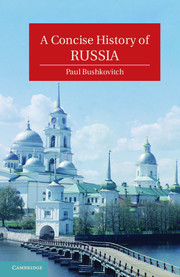Book contents
- Frontmatter
- Contents
- List of Figures
- Abbreviations
- Acknowledgments
- Prologue
- 1 Russia before Russia
- 2 Moscow, Novgorod, Lithuania, and the Mongols
- 3 The Emergence of Russia
- 4 Consolidation and Revolt
- 5 Peter the Great
- 6 Two Empresses
- 7 Catherine the Great
- 8 Russia in the Age of Revolution
- 9 The Pinnacle of Autocracy
- 10 Culture and Autocracy
- 11 The Era of the Great Reforms
- 12 From Serfdom to Nascent Capitalism
- 13 The Golden Age of Russian Culture
- 14 Russia as an Empire
- 15 Autocracy in Decline
- 16 War and Revolution
- 17 Compromise and Preparation
- 18 Revolutions in Russian Culture
- 19 Building Utopia
- 20 War
- 21 Growth, Consolidation, and Stagnation
- 22 Soviet Culture
- 23 The Cold War
- Epilogue
- Further Reading
- Index
14 - Russia as an Empire
Published online by Cambridge University Press: 05 June 2012
- Frontmatter
- Contents
- List of Figures
- Abbreviations
- Acknowledgments
- Prologue
- 1 Russia before Russia
- 2 Moscow, Novgorod, Lithuania, and the Mongols
- 3 The Emergence of Russia
- 4 Consolidation and Revolt
- 5 Peter the Great
- 6 Two Empresses
- 7 Catherine the Great
- 8 Russia in the Age of Revolution
- 9 The Pinnacle of Autocracy
- 10 Culture and Autocracy
- 11 The Era of the Great Reforms
- 12 From Serfdom to Nascent Capitalism
- 13 The Golden Age of Russian Culture
- 14 Russia as an Empire
- 15 Autocracy in Decline
- 16 War and Revolution
- 17 Compromise and Preparation
- 18 Revolutions in Russian Culture
- 19 Building Utopia
- 20 War
- 21 Growth, Consolidation, and Stagnation
- 22 Soviet Culture
- 23 The Cold War
- Epilogue
- Further Reading
- Index
Summary
The Russian Empire's foreign wars over the centuries laid the foundation for its expansion to include the whole of northern Eurasia. Of course by British standards, the results were not impressive. Most of the Russian Empire lay in Siberia, the largest part of which was seemingly impenetrable forest and tundra. Russia's newest acquisitions in Central Asia were small in population and were poor – no equivalent to India or even Burma. The resultant state included extensive areas on its borders with non-Russian populations, effectively two empires, a traditional land empire in Europe and an attempted imitation of the British example in Central Asia. In both west and south internal and foreign politics were inextricably intertwined.
Nicholas I had understood that Russia's empire had very limited possibilities for expansion. After 1828 its main effort went into subduing the Caucasian mountain peoples already within Russia rather than the conquest of new territory. In Central Asia the army also concentrated on strengthening the existing frontier and control of the Kazakhs of the steppe while making no serious attempt at expansion. Even in the Balkans, Nicholas had pursued a status quo policy, preferring to maintain Russian influence in a unitary Ottoman state rather than run the risks of partition schemes. Even this modest policy had been too much for Britain and France, but it reflected the tsar's strategic prudence as well as his tactical blunders. The new situation after Crimea brought different possibilities.
- Type
- Chapter
- Information
- A Concise History of Russia , pp. 249 - 271Publisher: Cambridge University PressPrint publication year: 2011

